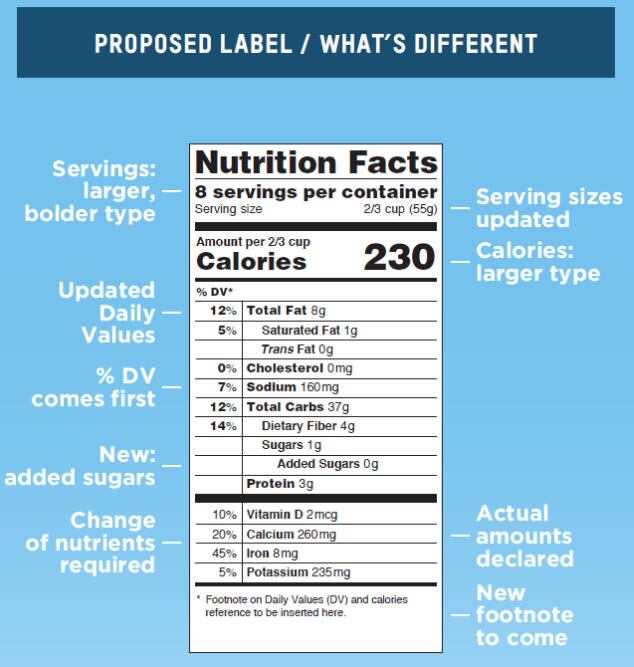Perhaps most notably, the proposed label would replace existing serving sizes to more accurately reflect what consumers actually eat or drink. For example, the new rules would require a 20-ounce soda bottle to be one serving size, making it easier to count calories. Serving sizes have long come under attack for being misleading, as many single-serving packages list multiple servings so the calorie count appears lower. (Read the full text of the FDA proposal here.)
“For 20 years consumers have come to rely on the iconic nutrition label to help them make healthier food choices,” said FDA Commissioner Margaret A. Hamburg, MD. “To remain relevant, the FDA’s newly proposed Nutrition Facts label incorporates the latest in nutrition science as more has been learned about the connection between what we eat and the development of serious chronic diseases impacting millions of Americans.”
As was expected by many, calories would appear in larger type on the new label, further reflecting a shift toward concern with calories consumed among consumers and the food and beverage industry alike.
In another largely anticipated change, the new labels would remove the much-maligned “calories from fat” designation, while still requiring “total fat,” “saturated fat,” and “trans fat” on labels, as research shows the type of fat is more important than the amount.
The new label would also place increased emphasis on certain nutrients that US consumers aren’t getting enough of—requiring manufacturers to label amount of vitamin D (for bone health) and potassium (helps lower blood pressure). Vitamins A and C would no longer be required on the label, though manufacturers could declare them voluntarily.
Added sugar would be on new labels, but consumers don't know how much they're meant to have in a day
Somewhat surprisingly, the FDA has proposed labels will state if foods have added sugars, though the agency hasn’t proposed including a Daily Value (DV) for added sugar, which drew criticism from CSPI, despite that the consumer advocacy group largely supported the proposed changes.
Still, CSPI applauded the move to add a line for added sugar as “a major step forward".
“However, the group will strongly urge the FDA to define a DV for added sugars so consumers know how much of a day’s worth a food contains,” CSPI said in a statement issued this morning. “CSPI recommends a DV of 25 grams—about six teaspoons—considerably less than the 23 teaspoons the average American now consumes.”
The Academy of Nutrition and Dietetics also expressed support the proposed changes, but president Glenna McCollum echoed concerns over consumer confusion when it comes to concepts like "added sugar" and DV.
“Despite the improvements announced today, many Americans are not familiar with how to use the information on the existing Nutrition Facts panel. To make these changes fully meaningful for consumers, the Academy recommends implementing a sustained, adequately funded nutrition education initiative empowering consumers to use the new label to make informed decisions to eat healthfully,” Dr. McCollum said in a statement.
"The nutrition facts panel is only one source of information, which is why sustained support for educational programs and individual counseling by registered dietitian nutritionists is essential.”
DV for sodium would be lowered to 2300 mg, processed fiber would be excluded from 'fiber' designation
Meanwhile, CSPI also took issue with the FDA’s approach to sodium in its proposed revisions, as the agency proposed lowering the DV from 2400 to 2300 mg instead of 1500 mg, which the American Heart Association has recommended.
Elsewhere, the FDA also proposed that “fiber” listed on nutrition facts labels exclude purified, processed fibers such as maltodextrin and inulin, which it says are not as beneficial as the intact, unprocessed fiber in whole foods.
Both CSPI and the Academy said they would also continue to campaign for a mandatory front-of-package nutrition labeling system, as proposed in the 2013 Food Labeling Modernization Act.
“Nutrition facts labels are a success because the FDA, and not the food industry, decides what’s on the label and what the label looks like,” said CSPI executive director Michael Jacobson, calling out the Facts Up Front system put forth by the Grocery Manufacturers Association and the Food Marketing Institute.
“The industry’s ‘Facts Up Front’ isn’t designed to promote the healthiest diets but to keep the government from requiring top-notch front-of-package labeling."
The FDA's proposed labeling changes affect all packaged foods except certain meat, poultry and processed egg products. The agency projects food companies will have to spend around $2 billion to change labels. It is accepting public comment on the proposed changes for 90 days.

